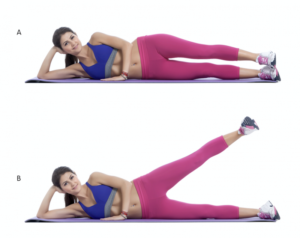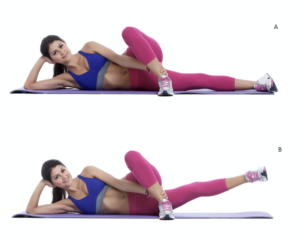Exercising doesn’t always feel like the most exciting or fulfilling task. Although some love fitness training so much they can’t imagine their life without it, some of us don’t share the same love and dedication for exercising as we do, say, Netflix. Yet we want to see results. So how can we find a compromise? Whether you’re a lazy gym-goer or simply can’t fit in the time, there’s always exercises at home to target those troublesome areas. Leg exercises, in particular, aren’t always glamorous. Sometimes, the leg area even gets neglected as people tend to focus on what they believe others will look at the most; their stomach and upper-body area. But everyone needs good leg development for a complete body.
Not only do toned legs look good, but they’re also a source of strength and therefore shouldn’t be neglected. In addition to amazing strength ability, the legs also have lots of endurance. Think about how often you rely on your leg muscles to get you through a day of working, completing tasks or running errands. Our legs are actually outfitted with a higher proportion of endurance muscle fibers for this very reason. As well as building leg strength, the good news is leg exercises can also play a huge role in weight loss and preventing lower-body injuries. So, if you’re having trouble finding the motivation or time to get a good leg workout in, here are some quick and easy exercises to try at home that target the front, back, and inner thigh surface as well as having other incredible benefits! Let’s get started:
1. High-Knee exercises (pictured above) are great to start off with. Not only does it target your upper things but it tones your core, your buttocks, your calves and can even help increase your metabolism! Because of the one-legged stance during the movement, this exercise even helps improve your balance! What more could you ask for? This exercise can also help achieve aerobic intensity if you’re repetitively going through your high-knee exercises for an extended time, which helps to burn calories faster and therefore boosting your metabolism. To perform the standard high-knee exercise, www.livehealthy.chron.com recommends standing with your legs about shoulder-width apart. Lifting one leg, bring your knee up towards your chest, holding for a second or two before lowering your leg back to the floor. Seems easy, right? Next, bring your opposite leg upwards in the same motion and continue to move back and forth between your right and left side. The website also warns not to arch or round your lower back and to keep your pelvis stationary as an improper form can cause back strain. The sets of power muscles in this exercise that lift your leg as you bend your hip can help you to not only target and strengthen your inner thigh but also your outer hip areas. As your body works to maintain balance on the standing leg, this balancing act helps tone your calf, quadriceps, hamstrings and buttock muscles on the standing leg. Once you have nailed the standard variation, there are other variations you can move on to in order to target more additional muscles in your leg and core.
2. Deep/Full squats (pictured below) are better for your knees, better activate the gluteal muscles and work your leg muscles better than parallel squats. Squats are a popular exercise of choice, but many neglect the full squat for the parallel squat (where your butt goes down to being level with your knees). This exercise isn’t always easy; not everyone can get their butt lower than their knees easily or comfortably while still keeping their feet flat on the ground (which is proper position). Others are concerned that full squats are bad for their knees. Well, according to www.bodyrock.tv, there are actually numerous ways in which the full squat is actually good for you. The website says that studies show there’s actually no difference in impact on the knee joint between parallel squats and full squats and full squats may actually increase knee stability when performed correctly. Not only are deep squats better for your knees but they also significantly increase activation of the gluteal muscles which are estimated to be 25% more engaged. In order to do a deep squat properly, your hips and butt need to go low enough so that you’re almost in a crouching position. It is also essential that your feet are flat on the floor or else the position is incorrect. Full squats strengthen ligaments, promote good flexibility at the ankles and hips and can even help alleviate back pain. Most importantly, squats are well known for helping to build your hamstrings, quadriceps, calves and of course, glutes.
If the thought of standing exercises seems unappealing as a quick at-home or before-bed exercise regimen, here are two more leg exercises that can be done lying down. You can even try them in bed! It doesn’t get much better or easier than that. If you want to incorporate all four of these incredible exercises into your routine, try doing the standing ones first and finishing off with these in order to reach a more relaxed finish.
3. Lateral leg raises (pictured above) have great strengthening benefits. According to Livestrong, this single exercise utilizes multiple muscle groups and offers numerous functional advantages. Although it appears quite easy to do, they stress the importance of proper form as it’s essential to injury prevention. Focus on keeping that one side of your body in contact with the ground, particularly from hip to ankle. Rest on your elbow, but ensure your back is in line with your legs. When raising your leg, lateral implies movement away from the midline of the body. So, keeping your core muscles tight, lift your upper leg about 45 degrees and lower it in a controlled, smooth manner. This can also be done standing, but lying on your side will increase ease and comfort. If you want to challenge yourself and do up-right lateral leg raises, your leg needs to move outward as opposed to when you’re lying down on your side and moving your leg upward. Stand up on your right leg with your back straight and keep your knee slightly bent. Holding your left foot a few inches off the ground, lift the leg as high as you can and work towards 45 degrees with the floor. Lower it back to the starting position and repeat. An important tip is to rest your hands on your hips or the ground (when in a lying position) to prevent your arms from becoming involved or utilized in the exercise.
4. Inner thigh lifts (pictured below) will tighten and strengthen your inner-thigh muscles. This exercise is perfect for those looking to tone their legs. Staying in that lying position, make sure to start on your side, lengthening your bottom leg and crossing your top leg over the bottom one while resting either your top knee or the top of your foot on the floor. You can prop your head up on your hand or rest your head on your arm. Keeping your torso steady, concentrate on working your inner thigh while trying not to move your back during the motions. Make sure your pelvis is level and that your waist is pulling away from the floor a bit. Now that you have the form down, the great part about inner thigh lifts is how many options it offers. Popsugar outlines a few variations: you could do straight-up lifts where as you exhale you lift your bottom leg and lower it back down as you inhale (without ever letting it touch the floor). You could also do tiny pulses, where instead of lifting your bottom leg and lowering it back down, keep it in the air and pulse 10-15 times. If you really want to feel the burn, try making small, controlled circles clockwise and then counterclockwise as your bottom leg is lifted off the ground. This is a variation where it is critical to maintain focus on steadying your back and ensuring your torso remains in position on the ground.







Post your comment